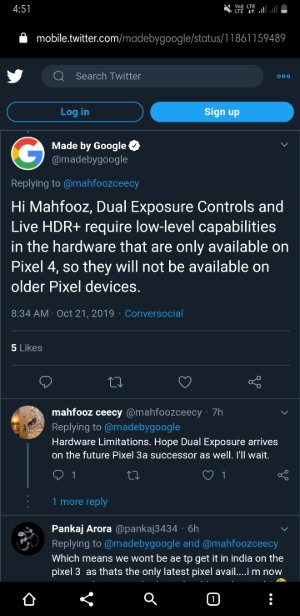Google Pixel phones are known for the vanilla Android experience as well as the successor to Nexus lineup. However, the prime focus was shifted to the camera department since the launch of the original Pixel back in 2016.
Google probably packed in the best computation photography techniques you could find on a smartphone inside the current gen Pixel phones. This was, later on, picked up by the mid-rangers Pixel 3a and 3a XL.
Moreover, Google Pixel devices are known to pass some of the latest features from the newer generation on the older generation via an OTA update. However, that does not seem to be the case for the Pixel 3 and 3a series (or the older ones).
![]()
Call it a disappointment, but some of the new functionalities which were featured by the recently launched Google Pixel 4 i.e. the Dual Exposure Controls and Live HDR+ will not be passed on to legacy Pixel phones such as 3 and 3a series.
For those who do not know, the Live HDR+ feature on the Google Pixel 4 series allows the user to see how the HDR+ processed image will look while capturing, straight in the viewfinder.

Moreover, the dual exposure controls give the user access to two control bars via which you can now control the shadow level and the overall exposure in real-time.
Matter of fact, this piece of information was confirmed by the official twitter handle of Google stating that the Dual Exposure and Live HDR+ will remain exclusive to the Google Pixel 4 series.

Besides, Google made it clear that these features require hardware capabilities that the Pixel 3 and 3a series does not feature. Though features like astrophotography and Android 10’s Live Caption are some of the features that will come to the older generations of Pixel phones.
Reacting to this, users on Reddit gave their views on Google for such a move that deprives the legacy Pixel devices of such features:

Now, all hopes depend on the GCam mod’s developers. Though, it seems unlikely as both the new features of the Pixel 4 series require specific hardware for attaining those results.
But we cannot rule the fact out that the GCam has made it possible for phones to do things out of their territory and achieve some great camera results.
In another surprising move by Google, the Pixel 4 will not be available for the users in India. This is due to the fact that the Pixel 4 smartphones use a radar chip (Project Soli) that requires certain permissions to be approved by the government.
But instead of bringing in a standard (maybe with a fingerprint or 3D face scanner) variant, Google straightaway decided not to bring the Pixel 4 to one of the biggest markets of Android.
A bold move by the company, but we will see what impact does this move has on the sales figures of the Pixel 4 devices.
PiunikaWeb started as purely an investigative tech journalism website with main focus on ‘breaking’ or ‘exclusive’ news. In no time, our stories got picked up by the likes of Forbes, Foxnews, Gizmodo, TechCrunch, Engadget, The Verge, Macrumors, and many others. Want to know more about us? Head here.

